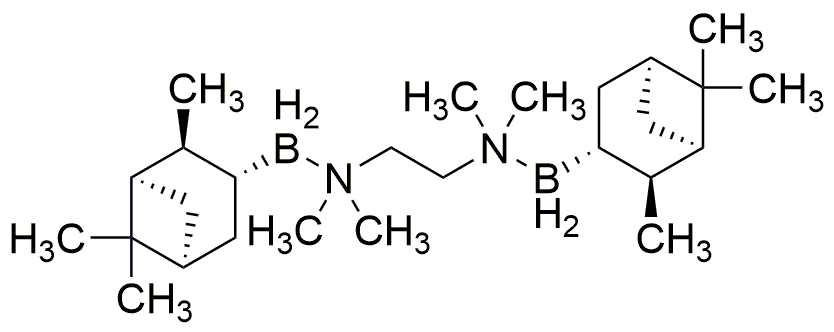(-)-Isopinocampheylborane TMEDA Complex is widely utilized in research focused on various applications, particularly in organic synthesis and catalysis.
- Asymmetric Synthesis: This compound is crucial in the synthesis of chiral molecules, which are important in pharmaceuticals. Its ability to facilitate enantioselective reactions makes it valuable for creating drugs with specific desired effects.
- Catalyst in Organic Reactions: It serves as an effective catalyst in various organic reactions, such as hydroboration. This application is particularly beneficial in the production of fine chemicals and agrochemicals.
- Research in Material Science: The compound is used in the development of new materials, including polymers and nanomaterials, due to its unique reactivity and properties.
- Environmental Chemistry: It plays a role in the study of environmental processes, helping researchers understand the behavior of pollutants and develop methods for remediation.
- Advancements in Organometallic Chemistry: This complex contributes to the advancement of organometallic chemistry, providing insights into reaction mechanisms and leading to the discovery of new catalytic processes.
General Information
Properties
Safety and Regulations
Applications
(-)-Isopinocampheylborane TMEDA Complex is widely utilized in research focused on various applications, particularly in organic synthesis and catalysis.
- Asymmetric Synthesis: This compound is crucial in the synthesis of chiral molecules, which are important in pharmaceuticals. Its ability to facilitate enantioselective reactions makes it valuable for creating drugs with specific desired effects.
- Catalyst in Organic Reactions: It serves as an effective catalyst in various organic reactions, such as hydroboration. This application is particularly beneficial in the production of fine chemicals and agrochemicals.
- Research in Material Science: The compound is used in the development of new materials, including polymers and nanomaterials, due to its unique reactivity and properties.
- Environmental Chemistry: It plays a role in the study of environmental processes, helping researchers understand the behavior of pollutants and develop methods for remediation.
- Advancements in Organometallic Chemistry: This complex contributes to the advancement of organometallic chemistry, providing insights into reaction mechanisms and leading to the discovery of new catalytic processes.
Documents
Safety Data Sheets (SDS)
The SDS provides comprehensive safety information on handling, storage, and disposal of the product.
Product Specification (PS)
The PS provides a comprehensive breakdown of the product’s properties, including chemical composition, physical state, purity, and storage requirements. It also details acceptable quality ranges and the product's intended applications.
Certificates of Analysis (COA)
Search for Certificates of Analysis (COA) by entering the products Lot Number. Lot and Batch Numbers can be found on a product’s label following the words ‘Lot’ or ‘Batch’.
*Catalog Number
*Lot Number
Certificates Of Origin (COO)
This COO confirms the country where the product was manufactured, and also details the materials and components used in it and whether it is derived from natural, synthetic, or other specific sources. This certificate may be required for customs, trade, and regulatory compliance.
*Catalog Number
*Lot Number
Safety Data Sheets (SDS)
The SDS provides comprehensive safety information on handling, storage, and disposal of the product.
DownloadProduct Specification (PS)
The PS provides a comprehensive breakdown of the product’s properties, including chemical composition, physical state, purity, and storage requirements. It also details acceptable quality ranges and the product's intended applications.
DownloadCertificates of Analysis (COA)
Search for Certificates of Analysis (COA) by entering the products Lot Number. Lot and Batch Numbers can be found on a product’s label following the words ‘Lot’ or ‘Batch’.
*Catalog Number
*Lot Number
Certificates Of Origin (COO)
This COO confirms the country where the product was manufactured, and also details the materials and components used in it and whether it is derived from natural, synthetic, or other specific sources. This certificate may be required for customs, trade, and regulatory compliance.

